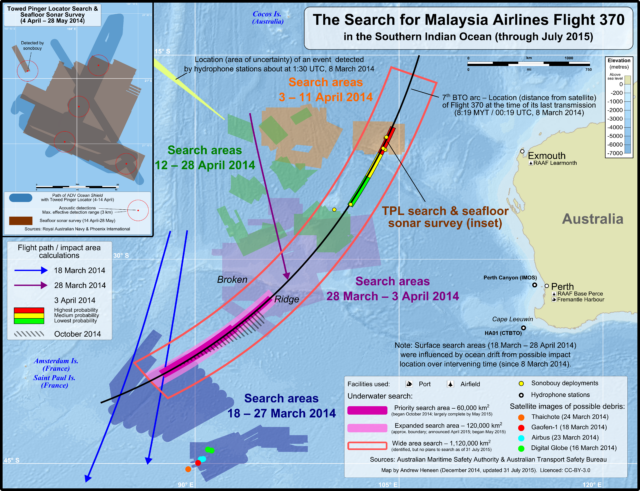
This week’s guest post is not actually here. It’s over at the Guardian: MH370: one of aviation’s biggest mysteries remains unsolved 10 years on by Oliver Holmes.
I first spoke to Oliver a few years back when he was writing a different piece on the loss of Malaysia Airlines 370, and I was impressed with his curiosity and thoroughness. When he contacted me about this article, I was less excited. Quite honestly, I didn’t think I had anything new to say about the issues, other than a few muttered comments about the Netflix special and lack of basic fact checking.
There’s a lot of excitement about Ocean Infinity’s push to reopen the search, and of course, it would be amazing if the wreckage of the Boeing 777-200ER was found, let alone the data recorders. Technology has moved on over the past ten years and perhaps there really is an opportunity to discover something new. But I keep returning to Air France 447, where they knew exactly where the aircraft had entered the Atlantic and yet still spent two years searching a 4,000 km2 area. Only once the search area was reduced to 75 km2 did they finally discover the data recorders.

In the case of Malaysia Airlines flight 370, the Cockpit Voice Recorder is highly likely to have two hours of silence, as we have no reason to believe that there was any manual control of the aircraft for the final five hours of the flight. The FDR will have something for us, presuming it has survived, but whether that data will explain what happened that day in the cockpit is another story.
So, I regretfully wrote Oliver that although we had learned much from this tragic situation, I had nothing new to say.
Oliver immediately emailed me back and asked a great question: What have we learned? That was much more interesting to me (he’s really good at that), with the result that I wrote him half a novel. I always consider these opportunities to be like an iceberg — I know most of what I write will never see the light of day, but I like to hope that it will hope inform the final piece and give the journalist a better idea of some of the not-so-obvious issues. Oliver, if you are reading this, I’m sorry!
I realised today that I could share the longer version with you! This is excerpted from the email.
The most practical change is to the Underwater Locator Beacons. These beacons help SAR (search and rescue) find survivors when an aircraft crashes into the sea. They transmit a ping on a specific frequency every second, with a detection range of 1-2 kilometres under normal conditions at full strength. However, the beacons installed on the accident aircraft were due for an overhaul; Malaysia Airlines claimed that the batteries didn’t need replacing for a few more months, but it called into question how long the beacons would keep broadcasting. With the aircraft at the bottom of the Indian Ocean, only the full-power signal would be detected, which meant they had at best thirty days to try to pick up the pings from directly over the aircraft.
EASA released new proposals for underwater locating detectors, which have since been adopted. EASA now requires all commercial airliners operating over oceanic areas to have an Underwater Locator Beacon which will transmit full-strength for at least 90 days. Skybrary’s ULB page has more details.
I mentioned the Inmarsat flight tracking in yesterday’s mail. What’s exciting is that we discovered that this would even be possible. When MH370 was first reported missing, the search centred on the South China Sea, based on the last communication from the flight crew. Then Inmarsat released the bombshell that they continued to receive faint pings from the MH370 ACARS system. This meant that the Boeing 777 was still flying for seven hours after it had dropped out of contact. Only after this information had gone public did the various military installations confirm that they’d seen something on primary radar.
Satellite data had never been used to track an aircraft before; however, in this case, it was critical as the data analysis proved that the aircraft had gone south after coming around Malaysia, moving the search to the Indian Ocean. This was proved correct through other evidence, most recently, the pieces of aircraft debris that drifted on shore. That early information could have been critical; no one knew it was possible at the time.
Eventually, debris washed to shore and some 18 pieces were confirmed as almost certainly from the wreckage of MH370. The analysis of the flaperon found on Réunion led to scientists from all over the world analysing tide data and drift modelling in unprecedented numbers. One of my favourite aspects is that the barnacles were the right age to have attached after the crash and were only recently dead (with “a strong odor”) The Ars Technika article from 2023 is a bit easier to follow and explains how the age and type of the barnacles found on the flaperon might tell us more precisely where the flaperon started.
An interesting connection came up just a few weeks ago. At the time, The Australian Transport Safety Board concluded that over the five hours when MH370 was travelling south, there was no evidence of manual changes, leading most to believe that by now, the flight crew was unresponsive. This is similar to the “ghost flight” of Helios Airways flight 522, which crashed in 2005 after the flight crew were incapacitated by hypoxia.
Last month, the door plug fell off of Alaskan Airlines flight 1282: as the cabin depressurised, the pilots were taken by surprise when the flight deck door burst open. Cockpits have been kept locked since the “9/11” attacks in the US despite some concern about access to the cockpit in an emergency. The NTSB reported that Boeing had confirmed that in the case of a depressurisation event in the cabin, the flight deck doors on the Boeing 737 MAX automatically spring open to release pressure on the cockpit. Speculation is that this had not been documented to avoid it being used by nefarious characters to access the flight deck. Personally, I suspect that, as with other features of the MAX, it was not seen as critical information that the pilots needed, so Boeing didn’t include it in the pilot documentation.
Either way, this is clearly a response to multiple cabin decompression instances, including potentially MH370. One of the theories (which I don’t see as likely) is that the captain of MH370 deliberately depressurised the cabin to quickly disable the passengers. This would be a bad idea in the Boeing MAX as the flight deck door would open, allowing easy access to the rogue pilot.
It may also be worth looking at the length of the cockpit voice recordings. This subject is in the news again from the aftermath of Alaska Airlines flight 1282: NTSB: Retrofit all Cockpit Voice Recorder-Equipped Airplanes With 25-Hour CVRs.
Originally, cockpit voice recorders kept just thirty minutes of the audio; this was later expanded to two hours. In Europe and the UK, as a direct result of MH370, aircraft built after 2021 have recorders that hold twenty-five hours of data: CAA regulations: cockpit voice recorder (also mentions the 90-day underwater beacon).
However, this isn’t the case in the US. Although the NTSB doesn’t mention MH370, it is another example where the two-hour limitation is a serious hindrance. Even if we recovered the digital recorders (CVR and FDR) from MH370, the cockpit voice recorder likely only recorded two hours of silence from the unresponsive pilots. We’d know more from the parameters recorded on the Flight Data Recorder, so it would still be helpful! But most of us want to know why the aircraft turned off course in the first place. Without the audio from the cockpit, we might never have the answer to this, even if we had the “black boxes”.
So, as we look over the past ten years, what else do you think has changed as a result of the disappearance of Malaysia Airlines 370? What might I have mentioned that I forgot?
To save you scrolling up, Oliver’s piece is here: MH370: one of aviation’s biggest mysteries remains unsolved 10 years on. If you’ve seen additional articles on the subject that you think we might like, please feel free to leave them in the comments!





